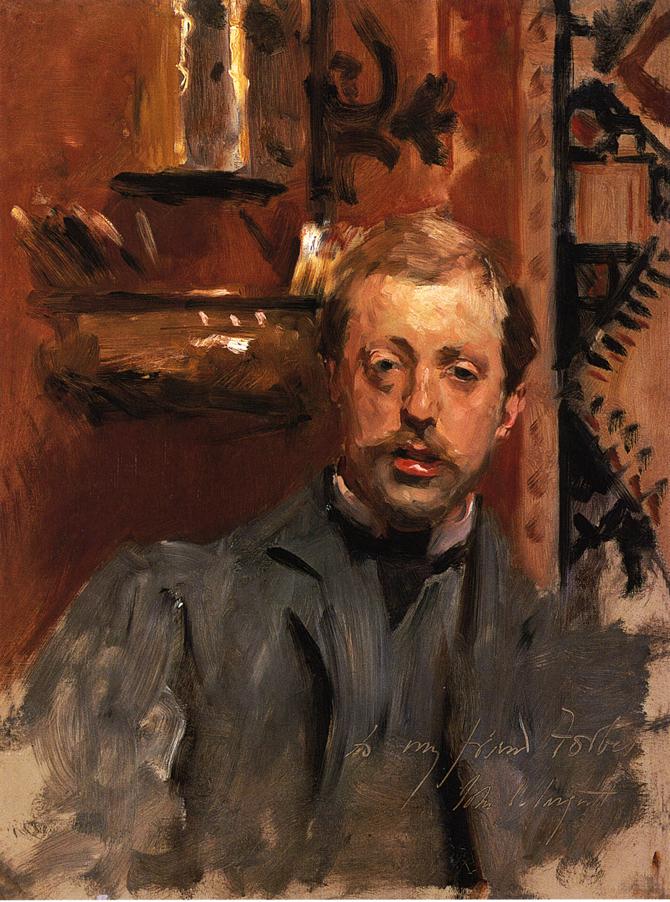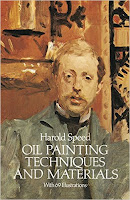 Let's resume the GJ Book Club with Harold Speed's 1924 classic The Science and Practice of Oil Painting
Let's resume the GJ Book Club with Harold Speed's 1924 classic The Science and Practice of Oil PaintingI'll present his points in bold either verbatim or paraphrased, followed by comments of my own.
1. "Painting is drawing (form expression) with the added complication of tone and color."
One of Speed's great contributions as a teacher is to narrow the gulf in students' minds between drawing and painting. As he says, the key is to break down the problem into easy stages and to take one thing at a time. In his previous book, he talked a lot about "mass drawing," by which he meant seeing form in terms of tone. The jump from charcoal to monochromatic oil isn't that great. His book is a good lifeline for those who have been frustrated by all the variables of a full-color painting.
 |
| J. S. Sargent, portrait of Charles Stuart Forbes |
From the standpoint of British art schools in the early 20th century, this impressionist way of seeing would have been regarded "Continental" or foreign, and not altogether acceptable. Eventually the British painters adopted the ideas of broken color and direct painting, but there were many in the Royal Academy who resisted it.
3. There are two modes of teaching: hard drilling on technical methods or leaving the student to figure out a technique on his own.
Some of the great teachers have come from both camps. Frank Reilly was more of the former, while Howard Pyle was more of the latter. But, Howard Pyle had the luxury of incoming students who had already been drilled on academic methods. The problem with the first method, Speed suggests, is that the student can get lost in technical issues and lose sight of their unique expressive potential. Later in the introduction Speed suggests that any art school should nurture the natural impulses of each individual student while providing the technical tools.
4. Every work of art starts with a nebulous idea.
This is true for me, and my thumbnail process is so important to work through. The buzzword for this process these days is "iteration." A lot of people seeing a finished painting assume the artist just sits down and renders out an idea fully formed.
5. "The best definition of a genius I have seen, is that he is described as the man most under the influence of these mental uprushes from the subconscious."
I know what he means, but I think the statement could be misleading. So many great geniuses like Michelangelo define genius as "eternal patience," or "the infinite capacity for taking pains" or "90% perspiration." Those uprushes from the subconscious only arrive, in my experience, in the context of steadfast effort. Patience, steadfastness, hard work, and an insatiable dissatisfaction. Who else but Sargent would have the intense application to wipe out a portrait again and again after 15-20 false starts.
6. Conscious / unconscious
Speed talks a lot about the relationship between the conscious and the unconscious. I love the idea that we should study consciously and paint intuitively. His preoccupation with the unconscious was very much of his time, as Henry James and other psychologists were building on what Freud had posited about the workings of the creative mind.
More recently, neuroscientists have explained the process by which skills are internalized. Beginners focus consciously on each skill, and then gradually, through practice, the neural pathways migrate into deeper subcortical regions of the brain.
7. Practical / intuitive
In the later part of the introduction, he sets up for the analytical approach that he'll use in his course of study, without neglecting the value of intuition and elusive rhythms that are harder to dissect. He wisely chooses to avoid the mysteries of the origins of creativity and to stick with more practical and rational matters.
At the end of the chapter, he decries the loss of drawing as a commonplace skill practiced by non-artists, perhaps a consequence of mystifying the process and undermining the value of traditional skills.
 He ends with a great quote: "It is only those you cannot discourage who are worth encouraging."
He ends with a great quote: "It is only those you cannot discourage who are worth encouraging."I'd love to hear your thoughts in the comments.
-----
In its original edition, the book is called "The Science and Practice of Oil Painting ." Unfortunately it's not available in a free edition that I know of, but there's an inexpensive print edition that Dover publishes under a different title "Oil Painting Techniques and Materials
." Unfortunately it's not available in a free edition that I know of, but there's an inexpensive print edition that Dover publishes under a different title "Oil Painting Techniques and Materials ," and there's also a Kindle edition.
," and there's also a Kindle edition.
----







25 comments:
Yes! I love the book club. I always looked forward to the posts about the last book the whole way through. I didn't comment as much as I'd like to have but the book was full of "Aha!" moments for me. Everything I wanted to say was always already said by you or commented. Hah! Well I'll have to buy the book today and dive in next week. Can't wait!
As Chuck Close opined, "Amateurs talk. Professionals go to work - every day." There's no other way to learn to paint than to paint - miles of canvas and gallons of paint required. Trial and error, and success. Hope is not a course of action. S/ Andy Weddington
Glad to see the Friday Book Club back James, and great timing (starting my second painting class next week)!
There were several great lines in the Introduction that I think apply to any creative effort. 'If one is too exquisite about the means of expression, one often ends up expressing nothing in particular.' I've been struck over the past several months by how many drawings and paintings I've seen that are incredibly executed from a place of technique but seem to lack any kind of depth of interest or emotion. Your comment about doing thumbnails or the iteration process speaks to the importance of figuring that out before all the effort to draw or paint something 'perfectly'. As Speed says about the importance of capturing those fleeting moments of inspiration 'Let him early acquire the habit of attempting to put something of all this down.' I take a sketchbook with me everywhere - the trick for me is making the time to pull it out and quickly sketch something down when those moments come, particularly when my drawing skills aren't where I want them to be. One a related note, I use my smart phone a lot to capture ideas for possible compositions and subjects, or for things like beautiful light and color that could be useful later in a composition or color scheme (screen grabs work great too).
Speed's comment '...keep in mind the fact that his training is only of use to him as it gives him a more adequate means of expression; and that however perfect a technique he may achieve, it in only of account as it enables him to more adequately to convey in his work the things that are moving him.' is great advice to any creative endeavor. It's easy when you're good at something to get by on technique or skill alone when in fact more effort and thought before creating something would have made it so much better! As a graphic designer and art director of many years I see this too often in those I work with and sadly myself at times. Like most things, one must remain diligent in fighting off mediocrity :)
As always thank you for your time and effort to keep the book club going, it's very much appreciated on so many levels!!
RE: Seadit's comment on "note-taking" with a smart phone - I do that too. I also used to use screen grabs, but the program I had for that no longer works with the newer Mac OS. (I use a MacBook Plus). Does anyone know of a screen grab that does work with the latest Mac OS?
(Sorry to sidetrack the conversation..)
Wonderful comments, everyone. You pulled out stuff that I passed over.
Tom, I do CMD+SHIFT+3 for the whole screen and CMD+SHIFT+4 in OSX Yosemite to grab a part of the screen. Does that still work with the new Mac OS?
Thanks James. I probably haven't tried that yet, but I will. I had been using a freeware program for the screen grabs (the name of the program escapes me). It was several years old and became incompatible with the latest OS releases. I recently installed El Capitan, which I like (so far). I'll report back...
It is a great book.
Is there a specific reason why you do not work in acrylic, James?
Thinking about Speed´s practicing , i wondered if acrylic is actually a good training instrument for realist painting cause it is so hard to get everything right with the fast drying times.
Tom - I haven't upgraded to El Capitan yet but I can't imagine Apple would have changed or deleted that feature.
To add to what James said, you can also do CMD+SHIFT+4 and hit the SPACE bar (the cursor changes to a small camera icon), then mouse click and it will screen grab whatever window you have active.
On a related note, if you have an iPhone you can hit the HOME and ON/OFF button at the same time and you'll screen grab whatever is visible on your phone (great for capturing things like Instagram images you want to remember or save).
I'm joining the club this time :)
I'm loving this book so far (I've read through the first 2 chapters, ready for next week already).
I agree with most of the things Speed says, I admit, especially when he talks about practice and academical study only being useful if subject to the impulse that comes from within.
As self-taught, I often struggle with my lack of academic knowledge, feeling like my limited technical skills are somehow denying the expression of something I would really like to put down on paper (or canvas). This is why I recently bought Guptill's book on sketching and rendering in Pencil, which will hopefully give me at least some kind of direction, helping me to understand what I am doing wrong (and I am, quite a lot).
I also love the analogy he makes with Golf, bringing up the subject of consciousness/unconsciousness. What I find limiting in my own experience, which is likely due to my lack of practice, is the time I need to think about everything I do when I paint. I guess, or better hope, this feeling of doing something which I can't grasp yet will become less and less apparent the more I practice.
I did, and do a bit of acting sometimes, and when I was starting I was told that all the things that I was finding so difficult to do, thinking consciously every time I had to do them, I would have been able to master only after reaching the point of not even knowing I was doing them, like breathing. But, heh, I guess that's the ultimate level of mastery in drawing and painting.
Lastly, I certainly agree with Speed's quote that James mentioned, although I believe the previous statement: "... and every obstacle should at first be put in the way of the aspiring artist,..." is a bit extreme, as not everyone might eventually become a genial artist, but just a moderate one. And perhaps, although loving art but not possessing enough strength of will, might prevent him/her from becoming an artist in the end, and grow up with frustration.
looking forward to next week! Spicy one :)
Seadit and James: That screen grab feature does indeed work In El Capitan. That's great news. Thanks again, and thanks seadit for that iphone screen grab tip.
I love the idea that... "we should study consciously and paint intuitively" This resonates, it's easy to get mired in trying too hard when approaching the canvas to paint. When you draw upon techniques learned from reading too intently it kind of snuffs out the deeper expression within.
It seems once your learn the foundations of painting its important to... simply paint and explore if you're to find that style that lets people connect emotionally to the work.
I've been playing with this notion lately and have been enjoying more success painting.
"we should study consciously and paint intuitively" I totally agree but am having a hard time implementing this concept. I either go into to detail and technique or make a complete mess.
Thanks for starting this book in the club, I have the Dover edition bought some time ago that I had started reading and left aside.
"Those uprushes from the subconscious only arrive, in my experience, in the context of steadfast effort. "
Matthew Syed, author of Bounce, recently wrote a great article on the BBC site about creativity being the result of many, many (usually unseen) iterations - that creativity is really the result of many failures, each one a learning experience. We rarely see that process, just the end result, which perpetuates the myth of creativity being a bolt from the blue.
He cites Dyson's five thousands failed prototypes, and there's a nice comment from Ed Catmull, president of Pixar, on what makes their films so good.
Here's the article: http://www.bbc.co.uk/news/magazine-34775411
I often find with older books (Dow's composition book comes to mind, too) that the opinions of the author are very much influenced by their times - it's the practical stuff that makes these books stand or fall years later, and Speed is always full of useful info in that regard!
I'm really looking forward to seeing the rest of your posts on this one James :)
Paul, thank you for that link to the BBC article on the value of failure to creativity. Fascinating read! And grist for a future post on GJ. Also, I agree with you about how Speed's view is shaped by his times. I'm reading his chapter on Modern Art, and it will be an interesting discussion!
I am looking forward to the review and discussion! The next chapter on ‘Modern Art’ is not that long but it covers quite a lot of food for thought. The chapter has two sections: ‘Social Influences’ and ‘Technical Influences.’ Perhaps we could focus on these two sections independently, as sort of appetizers, before moving on to the real meat and potatoes. (Tom Wolfe’s short book: ‘The Painted Word’ is an excellent companion to Speed’s Chapter on Modern Art.) Thanx for the Journey -RQ
https://archive.org/details/practiceoilpain00sologoog
Archive.org has a ton of great books for free including (i believe) this one!
https://archive.org/details/practiceoilpain00sologoog
Archive.org has a ton of great books for free including (i believe) this one!
Matt, thanks, yes, Archive is great for out-of-print books, but I think your link takes us to the Solomon Solomon book. It's another great book by a Royal Academician from the period, but it's different from the Speed book on painting.
There are free copies of the book floating around. Notably, in The Guttenberg project.
Thanks, Lucille. It should be in the public domain. Do you have a link? I found his book on drawing on P.G., but not the one on painting.
Can you give me your definition of broke color? I've heard it explained over the years & I'm always interested in each artists definition. Thanks, Jeff...
Jeff, what I mean by broken color is an area of color composed of smaller, adjacent patches that vary according to hue, value, or chroma.
Any chance you have a PDF of harolds what is the good of art? Dying to read it.
I started reading this book yesterday. 6 > I wrote "System 1" on the margin next to this section, in reference to Daniel Kahneman's concept of System 1 and System 2, related to what you mention regarding current research. With practice skills would move from exhausting System 2 control towards (seemingly) effortless and intuitive System 1.
I was both appalled and fascinated by the last couple of paragraphs. "It is only those you cannot discourage who are worth encouraging"... ok "and every obstacle should at first be put in the way of the aspiring artist" ouch!
I have an infant and I am really looking forward to the time he picks up a crayon. At the risk of spoiling him, I don't think I can bring myself to throw obstacles at him! The only good memories of my childhood was drawing and painting and crafting with my mother. Even if it never amounts to anything, just the flow state the kids find themselves in is enough to justify this use of their time.
Fun that I came across this blog post as I am reading this book now...Thank you for posting the photo of the source of the cover art, "J. S. Sargent, portrait of Charles Stuart Forbes," which upon closer look, shows what you discuss in your book, "Color and Light, Surfaces and Effects: Color Zones of the Face." Thank you because I had never heard of that. Really great.
Post a Comment